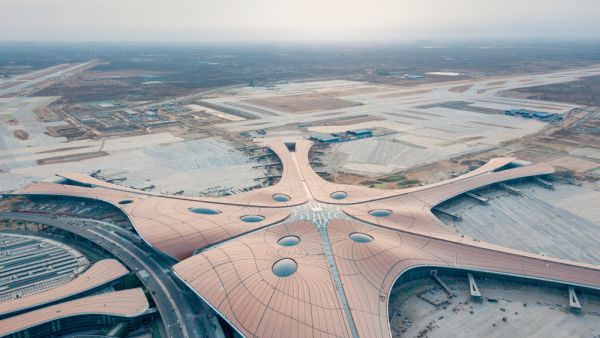Beijing Daxing International Airport, a sprawling hub that has cost £9 billion to build, is ready to welcome its first passengers after five years of construction.
The first commercial flight will arrive at the airport around September 20 and it will be operated by China Southern Airlines, according to state media.
The mega five-wing terminal building, designed by late British-Iraqi architect Zaha Hadid, features the country's most advanced security system empowered by artificial intelligence.
Passengers will be able to check in and board their flights by simply looking into cameras that can verify their identification by scanning their faces.
Airport workers will use a type of special AI monitor that can turn 360 degrees to carry out security checks, according to the country's official news agency Xinhua.
The airport's official opening date is set to be September 30.
The Chinese capital city currently has the world's second busiest airport. Beijing Capital International Airport, situated to the north-east of the city, handled 101 million passengers last year.
The new hub is expected to double the city's already impressive air transport capability.
With a total of seven runways in plan, Beijing Daxing International Airport occupies a piece of land four-fifth the size of Manhattan and is set to handle 100 million passenger a year in the long run.
It is located 100 kilometres (62 miles) away from Beijing Capital International Airport on the southern outskirts of the city.
The enormous structure went through five rounds of full operational rehearsals this month and last, and has passed various safety and administrative inspections.
The test-runs involved some 500 flights, 51,984 mock passengers and 35,270 pieces of mock luggage, said Xinhua.
{"preview_thumbnail":"https://cdn.flowplayer.com/6684a05f-6468-4ecd-87d5-a748773282a3/i/v-i-b…","video_id":"b893d5d5-cfb1-4156-af50-0c298b613a2a","player_id":"8ca46225-42a2-4245-9c20-7850ae937431","provider":"flowplayer","video":"UN Welcomes Proposal by Yemen’s Houthi to Halt Strikes on Saudi Arabia"}
According to state broadcaster CCTV, passengers will only need to go through one check before boarding their flights in Daxing. The check will combine the passport control and security screening processes.
More than 30 high-tech, infrared monitors have been installed at gates in the arrival section, which will check passengers' identity, collect their body temperature and scan their luggage within seconds.
The arrival hall is also equipped with extra speedy luggage conveyor belts which can send bags nearly twice as quick as normal machines.
Four runways will be complete when the first passengers check in at Daxing airport and a total of seven have been planned to handle China's growing number of air travellers.
It is due to process 72 million passengers, two million tonnes of cargo, as well as 620,000 takeoffs and landings per year by 2025.
While in the long run, the transport centre will boast an annual capacity of 100 million passengers, four million tonnes of cargo as well as 880,000 takeoffs and landings.
The gigantic airport is made up of 1.6 million cubic metres of concrete and 52,000 tonnes of steel.
Its 20-storey air traffic control tower is equipped with a state-of-the-art guiding system which could automatically identify potential collisions between aircraft on the aprons and runways, according to Northern China Air Traffic Control Bureau.
The tower is designed to resemble the shape of a feather from a phoenix, an immortal bird-like creature in ancient Chinese mythology.
Two of China's three major airlines, China Eastern Airlines and China Southern Airlines, will relocate to the airport and they will account for roughly four-fifths of the new airport's total traffic.
This article has been adapted from its original source.








